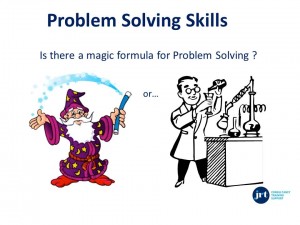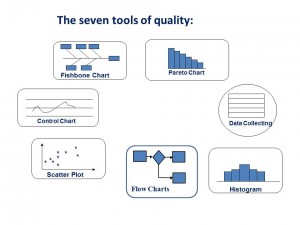Problem Solving skills
Is there a magic formula for Problem Solving ?
One danger in attacking problems is that we quite often lose patience, leap to action and in some cases compound the problem.
What is needed is a rational approach, an approach that is..
- Focused.
- Visible.
- Systematic.
Click on the summary below for a taster of the course content.
Taster of problem solving skills
Course objectives
The objective of this course is to introduce participants to a range of simple problem solving techniques :
- They can use to enhance their ‘expert’ role within their team.
- That they can use with their team to solve specific problem issues.
- Enable them to organise a corrective action programme.
What key concepts are taught on this course?
- The concept of variability and the associated cost of quality.
- Continuous improvement: Kaizen and the Deming cycle.
- The concept of the Internal Customer.
What techniques are taught on this course?
Techniques taught include :
- The 5 Why’s
- Cause-and-Effect Diagrams
- Data gathering using checklists
- Interpretation and presentation of data
- Histograms and bar charts
- Pareto analysis
- Flowcharts
- Scatter diagrams
- Run charts
- Control charts
- Force-field analysis
- Action planning using Gantt charts
How is a typical course organised? (All courses are client-customised).
| Objective | Problem Solving Techniques | Approach |
|
Managing and improving quality to meet customer requirements.
To train participants how to Plan to meet and if possible exceed customer requirements. To give participants the skills to define the root cause of a customer complaint or internal rejection and ensure they are able to identify an appropriate solution(s). To enable participants to understand the costs and benefits of resolution. To give participants the skills to develop an action plan so that the solutions identified are implemented. |
Stage 1: Defining and Measuring the problem :
….and be able to display and present information to others. (Extensive use will be used of current complaint/rejection data to facilitate this process).
Stage 2: Root cause analysis of the problem. To drill down to the root cause(s) of problems and be capable of identifying the vital few that will deliver the results… Introduce problem solving tools & techniques:
Practice using these tools and techniques using exercises. Identify the pros and cons of alternative approaches.
Stage 3: Managing the improvements To plan and evaluate the improvement process and be capable of engaging the team in the action plan.
Stage 4: Sustaining the improvements To understand the techniques of sustaining the improvements and ensuring the team’s ownership of the solutions. |
Great emphasis is placed throughout this module on :
|
Relating it to the real world
Throughout the course we investigate specific business problems and get the participants to use the above techniques to tackle problems, which are relevant, to them : often resolving real business issues during the training course.

